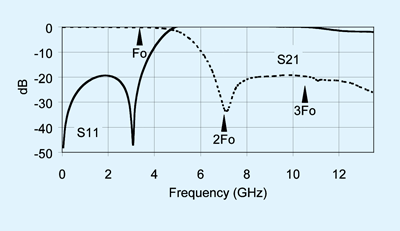Here’s help choosing the right filter for your design
BY RON DEMCKO
AVX
www.avx.com
The IEEE 802.16 and 802.11 families of standards specify broadband and high data rate wireless connectivity. The higher the data rate of a transmitted signal, the higher the signal-to-noise ratio required for the system. Emission regulations may also require additional filtering.
Filter basic design
Designing an optimal multistage Tchebysheff filter with high harmonics rejection is challenging due to size and cost limitations.

Fig.1: A multistage LPF.
In order to minimize physical size, manufacturers such as AVX use a limited number of stages with the addition of elliptical elements to improve high frequency rejection. The design of miniature bandpass filters (BPFs) is even more challenging. Manufacturers apply proprietary RFAP technology to build BPFs based on high Q-factor resonators.
Applications
Filters used in a standard architecture must reject unwanted signals. In order to improve this rejection for specific high harmonics, an additional LPF with low insertion loss may be included. In order to comply with emission regulations, LPFs can be added after the power amplifier (see Fig. 2 ).

Fig. 2: An example of additional filtering in Rx path (a) and in Tx path (b)
In multiband transceivers, which operate at several frequencies, LPF’s are used as additional decoupling elements in both the receiving and the transmitting channels. When several RF systems work simultaneously, e.g. WCDMA at 1.9 GHz and WiMAX/WLAN range accessories at up to 5.2 GHz, parasitic signals may form in the main channel, lowering the receiver sensitivity.
LPF realization using thin-film technology
Thin-film low-pass filters with passbands from dc to 5.5 GHz. These filters are ideal for rejection of harmonics, intermodes and preventing unwanted signals from creeping into the system.
Most high-frequency low-pass filters are based on fired ceramic technology. Layers of ceramic dielectric material and metal alloy electrodes are interleaved and then sintered at high temperature. This technology exhibits component variability in dielectric properties (losses, dielectric constant, and insulation resistance) as well as variability in electrode conductivity and physical size.
The low-pass filters can virtually eliminate these variances. Thin-film technology is commonly used for producing semiconductor devices. Applying this technology to the manufacture of LPF’s has enabled the development of components where both electrical and physical properties can be tightly controlled. Typical S11 and S21 curves are presented in Fig. 3 .

Fig. 3: LPF for 3.5 and 5.5 GHz.
The main features of thin-film low-pass filters can be summarized as follows:
• Very low insertion loss, typically 0.2 0.3 dB for W-LAN and WiMAX frequencies.
• High rejection ~35 dB of second harmonics.
• Temperature stability: identical performance within a wide temperature range.
• Excellent repeatability from unit to unit and from lot to lot.
• Standard 0402 and 0603 sizes.
LPF’s with LGA-type terminations (see Fig. 4 ). This termination is characterized by low parasitics, reduces component thickness and is suitable for standard industrial assembly.

Fig. 4 LPF with LGA termination. Left to right: LPF 0402; LPF 0603; LGA schematic.
BPF realization using thin-film technology
Thin-film technology allows manufacturing of high-quality miniature 0402 size BPF’s .
Figure 5 shows typical performance of an AVX bandpass filter.

Fig. 5: BPF for 5.2 GHz.
The main features of miniature BPFs are as follows:
• Low insertion loss, typically 1.7-1.8 dB.
• High rejection, typically 40 dB at 0.5 Fo and 1.5 Fo.
• Temperature stability and repeatable performance.
Related articles
“Heart-rate/fitness monitors go wireless,” By John Di Cristina, Maxim Integrated Products, http://www2.electronicproducts.com/Heart_rate_fitness_monitors_go_wireless-article-facn_maxim_feb2011-html.aspx
“Microwave and fiber drive future of wireless backhaul,” By Mark W. Andrews, TriQuint Semiconductor, http://www2.electronicproducts.com/Microwave_and_fiber_drive_future_of_wireless_backhaul-article-FAJH_TriQuint_Dec2010-html.aspx
“GPS-based time and frequency solutions,” By Dave Jahr, Ken Hartman, and Keith Loiselle, Connor-Winfield, http://www2.electronicproducts.com/GPS_based_time_and_frequency_solutions-article-facn_connor_feb2011-html.aspx
“Measuring RF in circuits,” Intersil, http://www2.electronicproducts.com/Measuring_RF_in_Circuits-video-90646260001.aspx
References:
1. G. Matthaei, L. Young, and E.M.T. Jones. Microwave Filters, Impedance-Matching Networks, and Coupling Structures . Artech House Books. 1980.
Advertisement
Learn more about AVX





